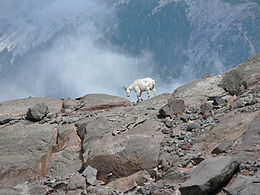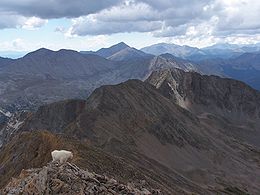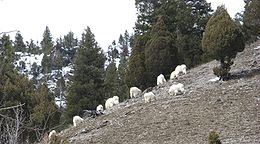ماعز جبلي
| ماعز جبلي Mountain Goat | |
|---|---|
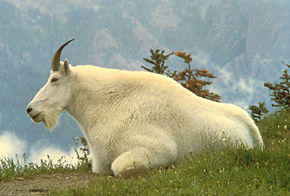
| |
| التصنيف العلمي | |
| مملكة: | |
| Phylum: | |
| Class: | |
| Order: | |
| Family: | |
| Subfamily: | |
| Genus: | Rafinesque, 1817
|
| Species: | O. americanus
|
| Binomial name | |
| Oreamnos americanus (Blainville, 1816)
| |
عنز جبال الروكي حيوان يشبه الظباء يعيش في أمريكا الشمالية ، وتُشبه العنز ، ولكنه ليس عنزاً حقيقية. وهو أقرب إلى حيوان الشمواه ، كما أنه ليس في جمال الكباش الجبلية ورشاقتها. ويغطي جسمه طبقة تحتية كثيفة من الصوف بالإضافة إلى طبقة أخرى خارجية من الشعر الأبيض الطويل. وتمنحه هذه الطبقة الدفء في بيئته الباردة العاصفة فوق جبال الروكي العالية التي لاتنمو بها الأشجار.
ويتراوح ارتفاع الذكر بين 90 و105سم عند الكتف، ويزن نحو 90 كجم. وله لحية طويلة تضفي عليه الوقار وقد يصل طول قرونه السوداء الرفيعة الملتفة نحو الخلف إلى 30 سم. أما أُنثى العنز فذات قرنين أصغر، ولحية أقصر من الذكر ولكل من الذكر والأنثى حوافر سوداء صغيرة. وتلد الأنثى في شهر مايو، أو يونيو، جديًا واحدًا. وتعيش العنز الجبلية في جبال الروكي الشمالية ، بدءاً من ألاسكا وجنوباً عبر غربي كندا، حتى ولايات واشنطن، وأيداهو، ومونتانا الأمريكية. وتتغذى بالنباتات كالحشائش، ونبات السعادى، وأوراق الشجيرات، وأغصانها. وتتميز بثبات أقدامها، عند تسلق ونزول الجبال والمنحدرات الصخرية. ويميل العنز إلى العزلة، فيما عدا موسم التزاوج في شهر نوفمبر.
تعرف العنز الجبلية (Oreamnos americanus), وهى أيضا معروفة بعنز جبال الروكي ، هي من الثدييات الكبيرة من ذوات حوافر متواجدة فقط في أمريكا الشمالية. وبالرغم من إسمها فهى ليست عنزاً حقيقية، حيث أنعا تنتمى الى جنس مختلف. انها تتواجد على ارتفاعات عالية، وهي راسخة القدم متسلقة، وغالبا ما تستند إلى المنحدرات الصخرية التي لا يمكن أن تصل إليها أعداؤها المفترسة.
. . . . . . . . . . . . . . . . . . . . . . . . . . . . . . . . . . . . . . . . . . . . . . . . . . . . . . . . . . . . . . . . . . . . . . . . . . . . . . . . . . . . . . . . . . . . . . . . . . . . . . . . . . . . . . . . . . . . . . . . . . . . . . . . . . . . . . . . . . . . . . . . . . . . . . . . . . . . . . . . . . . . . . . .
التقسيم والتصنيفات
عنز جبال الروكي تعتبر من شفعيات الأصابع حافريات من الفصيل شفعيات الأصابع و العائلة البقرية التى تشمل الظباء و الماشية. وتنتمى إلى تصنيف فرعى الماعز الظباء، إلى جانب اثنين وثلاثين من الأنواع الأخرى تشمل الماعز الحقيقية, والأغنام والشمواة وثور المسك. عنز جبال الروكي هو الفصيل الوحيد من الجنس Oreamnos. الإسم Oreamnos مشتق من الكلمة اليونانية oros (ساق ore-) 'جبل' (أو , في المقابل, oreas 'جبال حورية') والكلمةamnos 'خروف'.
المظهر العام ، والخصائص
Both male and female mountain goats have beards, short tails, long black horns, 15-28 cm in length, which contain yearly growth rings. They are protected from the elements by their woolly white double coats. The fine, dense wool of their undercoats is covered by an outer layer of longer, hollow hairs. In spring, mountain goats moult by rubbing against rocks and trees, with the adult billies (males) shedding their extra wool first and the pregnant nannies (females) shedding last. In the winter, their coats help them to withstand temperatures as low as -50 Fahrenheit (-46 Celsius) and winds of up to 100 mph (161 km/h).
A billy stands about one meter (3'3") at the shoulder to the waist. Male goats also have longer horns and a longer beard than nannies. Mountain goats typically weigh between 45 and 136 kg (100 - 300 lb.);[2] females are usually 10-30% lighter than males.
The mountain goat's feet are well-suited for climbing steep, rocky slopes, sometimes with pitches of 60 degrees or more, with inner pads that provide traction and cloven hooves that can be spread apart as needed. Dewclaws on the back of their feet also help to keep them from slipping.
المجال وبيئة الحياة
The mountain goat inhabits the Rocky Mountains and Cascade Range regions of North America, from northern Washington, آيداهو and مونتانا through British Columbia and Alberta, into the southern Yukon and southeastern ألاسكا. Its northernmost range is said to be along the northern fringe of the Chugach Mountains in southcentral Alaska. Transplanted populations can also be found in such areas as وايومنگ, Utah, Nevada, Oregon, كولورادو, South Dakota and the Olympic Peninsula of Washington.
Mountain goats are the largest mammals found in their high-altitude habitats, which reach elevations of 4,000 meters (about 13,000 feet) or more. Although they sometimes descend to sea level in coastal areas, they are primarily an alpine and subalpine species. Throughout the year, the animals usually stay above the tree line, but they will migrate seasonally to higher or lower elevations within that range. Summertime migrations to low-elevation mineral licks often take them several or more kilometers through forested areas.
أنماط الحركة
Daily movements by individual mountain goats are primarily confined to areas on the same mountain face, drainage basin, or alpine opening. Daily movements reflect an individual’s needs for foraging, resting, thermoregulation and security from predators or disturbance. Seasonal movements primarily reflect nutritional needs (e.g., movements to and from mineral licks/salt lick), reproductive needs (i.e., movement of pre-parturient females to “kidding” areas; movement to rutting areas), and climatic influences (i.e., movement to areas in response to foraging conditions). In general, seasonal movements are likely to exhibit a strong elevational component, whereby lower, forested elevations are used during the spring-summer (security cover effects) to access lower elevation mineral licks, and during winter (thermal cover effects) to access forage. The farthest movements are expected to be by dispersing mountain goats. Such movements are likely to involve mountain goats crossing forested valleys as they move between mountain blocks.
دورة الحياة والتكاثر
In the wild, mountain goats usually live twelve to fifteen years, with their lifespan limited by the wearing down of their teeth. In zoos, however, they can live for sixteen to twenty years.
Kids are born in the spring (late May or early June) after a six month gestation period. Nannies give birth, usually to a single offspring, after moving to an isolated ledge; post-partum, they lick the baby dry and ingest the placenta. Kids weigh a little over 3 kg (about 7 lb) at birth and begin to run and climb (or attempt to do so) within hours. Although they are mostly weaned within one month, kids follow their mothers closely for the first year of life (or until the nanny gives birth again, if this does not occur the next breeding season); nannies protect their young by leading them out of danger, standing over them when faced by predators, and positioning themselves below their kids on steep slopes to stop free falls.
Mountain goats reach sexual maturity at about thirty months. Nannies in a herd undergo synchronized estrus in late October through early December, at which time males and females participate in a mating ritual. Mature billies will stare at nannies for long periods, dig rutting pits, and fight each other in showy (though occasionally dangerous) scuffles. Young billies sometimes try to participate, but they are ignored by nannies; nannies will also sometimes pursue inattentive billies. Both males and females usually mate with multiple individuals during breeding season, although some billies try to keep other males away from certain nannies. After the breeding season is over, males and females move away from each other, with the adult billies breaking up into small bands of two or three individuals. Nannies form loose-knit nursery groups of up to 50 animals.
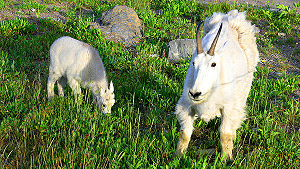
السلوك العدواني
Nannies can be very competitive and protective of their space and food sources. They will fight with one another for dominance in conflicts that can ultimately include all the nannies in the herd. In these battles, nannies will circle each other with their heads lowered, showing off their horns. As with fights between billies during breeding season, these conflicts can occasionally lead to injury or even death, but they are largely harmless. To avoid fighting, an animal may show a posture of non-aggression by stretching low to the ground.
In lower regions below the tree line, nannies also use their fighting abilities to protect themselves and their offspring from predators, such as wolves, wolverines, cougars, lynx and الدببة. Even though their size protects them from most potential predators in higher altitudes, nannies still must defend their young from golden eagles, which can be a threat to very young kids. Nannies have even been observed trying to dominate the more passive bighorn sheep that share some of their territory.
الغذاء
Although they have gained notoriety for their shows of aggression, mountain goats spend most of their time quietly grazing. Their diet includes grasses, herbs, sedges, ferns, moss, lichen, twigs and leaves from the low-growing shrubs and conifers of their high-altitude habitat.
In captivity, the mountain goat's diet can also include grain, alfalfa, fruits, and vegetables.
المراجع
- ^ Festa-Bianchet, M. (2008). Oreamnos americanus. القائمة الحمراء للأنواع المهددة بالانقراض 2008. IUCN سنة 2008. تم استرجاعها في 5 April 2009. Database entry includes a brief justification of why this species is of least concern.
- ^ National Geographic Mountain Goat Profile. animals.nationalgeographic.com. Retrieved on: December 29, 2007.
- Oreamnos americanus (TSN 180713). Integrated Taxonomic Information System. Accessed on 18 March 2006.
- A.W.F. Banfield (1974). The Mammals of Canada. University of Toronto Press. ISBN 0-8020-2137-9
- D. Chadwick (1983). A Beast the Color of Winter - The Mountain Goat Observed. Sierra Club Books. San Francisco. 208 p.
- Loyal J. Johnson (1994) [http://www.adfg.state.ak.us/pubs/notebook/biggame/mtn_goat.php Alaska Department of Fish & Game
. . . . . . . . . . . . . . . . . . . . . . . . . . . . . . . . . . . . . . . . . . . . . . . . . . . . . . . . . . . . . . . . . . . . . . . . . . . . . . . . . . . . . . . . . . . . . . . . . . . . . . . . . . . . . . . . . . . . . . . . . . . . . . . . . . . . . . . . . . . . . . . . . . . . . . . . . . . . . . . . . . . . . . . .


